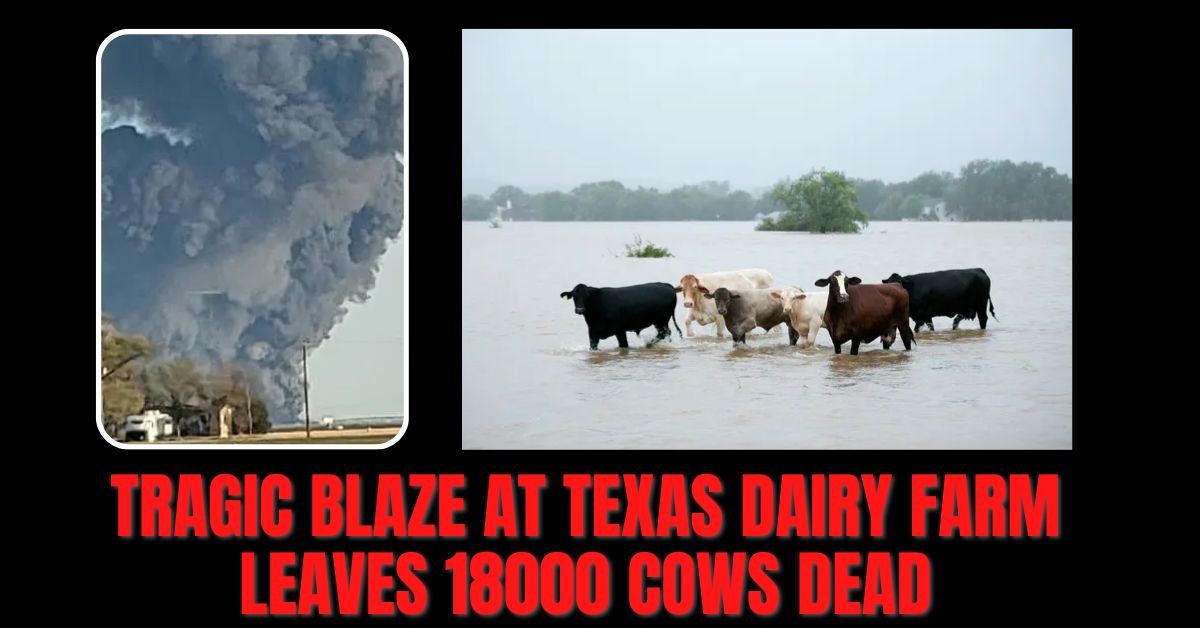Numerous dairy cows were crowded together in the holding pens, waiting to be milked, and were therefore trapped in dangerous conditions as the fire quickly spread throughout them. Officials were shocked by the number of livestock deaths left behind after putting out the fire at the West Texas dairy farm Monday evening: 18,000 head of cattle perished in the fire at the South Fork Dairy farm near Dimmitt, Texas, or about 20% of the cattle slaughtered in America on any given day.
As of Tuesday, the dairy farm worker who was rescued from the building was being treated at a hospital and was listed in critical but stable condition. There were no more fatalities among people. Roger Malone, mayor of Dimmitt, described it as “mind-boggling.” “I don’t believe it has ever occurred in this area. It’s truly tragic.
Since tracking barn and farm fires began in 2013 by the Washington-based Animal Welfare Institute, it was the largest single-incident death of cattle in the nation. According to Allie Granger, a policy associate at the institute, that easily surpassed the previous high, a 2020 fire at an upstate New York dairy farm that killed about 400 cows.
The Texas blaze “is the deadliest fire involving cattle we know of,” she claimed. In the past, there have been fires that killed hundreds of cows at once, but nothing compared to this.
Where Was the Texas Cattle Fire?
About 70 miles southwest of Amarillo, in Castro County, the fire’s source, is open prairie land dotted with dairy farms and cattle ranches. Bystander photos shared on social media showed the charred cows that were rescued from the structure as well as the large plume of black smoke rising from the farm fire.
What Caused the Dairy Farm Explosion?
According to County Judge Mandy Gfeller, the chief executive of the county, a malfunction in a piece of farm machinery may have resulted in the explosion and subsequent fire. She said the cause is still being looked into by Texas fire officials.
The facility had no other reported fires, according to Malone, the mayor. He claimed that the dairy had been operating in the area for just over three years and had between 50 and 60 employees. It was impossible to contact South Fork Dairy’s owners for comment.
How Many Cows Were Killed in the Dairy Fire?
She claimed that before being milked, the majority of the dead cows—a mix of Holstein and Jersey cows—were kept in a sizable holding pen. A little more than 90% of the farm’s total herd was 18,000 cows.
Given that a cow is generally worth around $2,000, the company’s livestock losses could total in the tens of millions of dollars, according to Gfeller. Losses to structures and equipment are not included in that. You’re going to suffer a terrible loss, she said. “Everyone involved in that operation has my deepest sympathies.”
You can also check out our most recent articles on this page:
- Celebrities to Perform at King Charles’ Coronation Concert: A Night to Remember
- Florida Governor Ron DeSantis Signed Into Law a Six-Week Abortion Ban!
- Actor Raquel Leviss in Mental Health Rehabilitation
How Did the Texas Dairy Compare With the Rest of the Country?
According to a trade organization called the Texas Association of Dairymen, Texas is home to 319 Grade A dairies with an estimated 625,000 cows that produce close to 16.5 billion pounds of milk annually, placing the state fourth in the nation for milk production.
According to the U.S. Department of Agriculture, Castro County produces 148 million pounds of milk per month from 15 dairies, ranking it as the second-highest producing county in Texas. South Fork Dairy was enormous even by Texas standards. Its 18,000 cattle made it almost ten times bigger than the typical Texas dairy herd.
Texas cattle have lost a lot of lives before, but rarely do so many perish in a single fire. According to the Texas Association of Dairymen, a blizzard in December 2015 killed off about 20,000 cattle throughout the Texas Panhandle.
According to Texas A&M AgriLife Extension Service, Hurricane Harvey in 2017 caused $93 million in livestock losses throughout the state and resulted in the drowning of thousands more people in Southeast Texas.
What Happens Next?
Officials from the state and the dairy industry are beginning the enormous and messy task of cleaning up 18,000 burned carcasses. The Texas Commission on Environmental Quality lists a number of requirements for the onsite burial of carcasses on its website.
These requirements include burying the animal at least 50 feet away from the closest well and noting the GPS coordinates of the location. However, mass graves are not mentioned anywhere. According to officials, the environmental quality commission and the AgriLife Extension Service are working together to help with the cleanup.
The mayor of Dimmitt, Malone, claimed to have taken emergency management courses where he learned how to properly dispose of animal carcasses following a disaster, but not one of this magnitude. He asked, “How do you dispose of 18,000 carcasses?” You just don’t run into that very often, she said.
